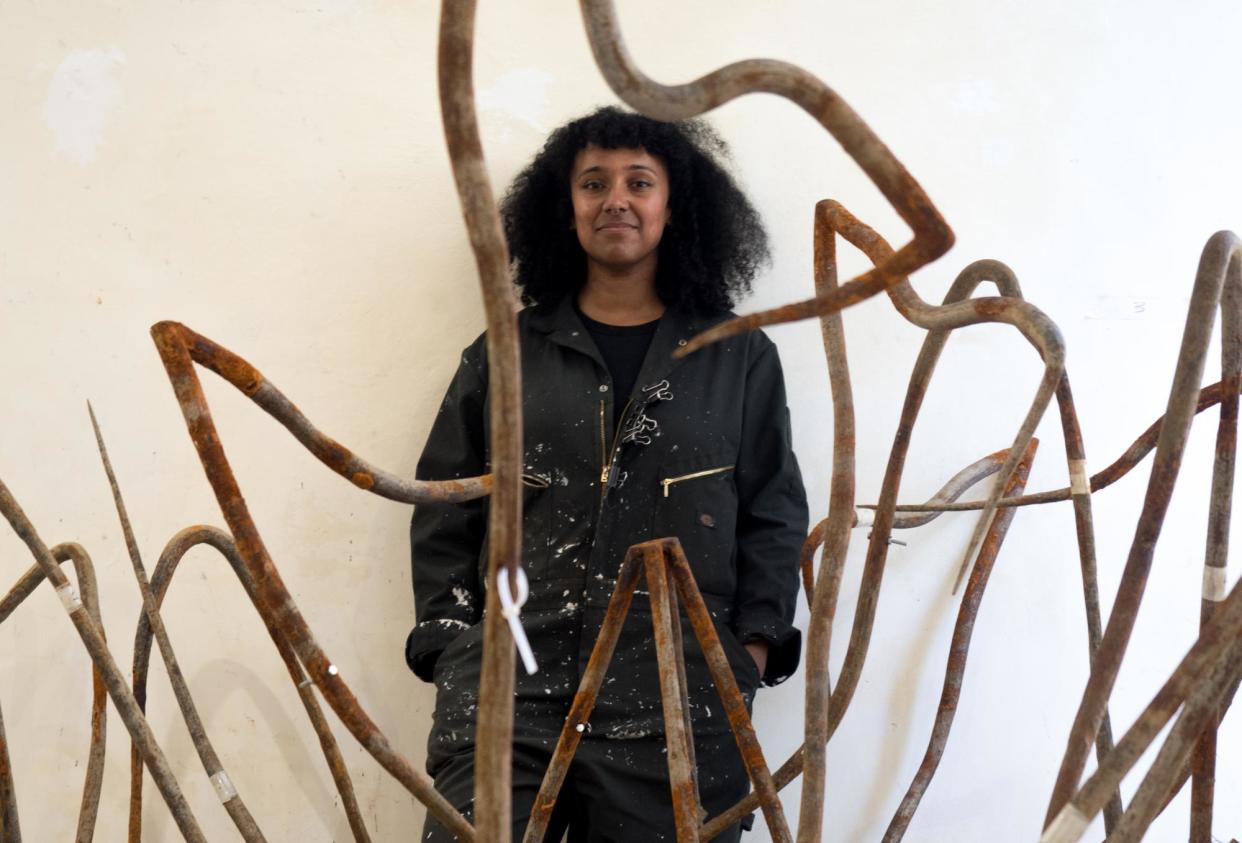‘I always want to grapple with an unruly beast’: the ghostly works of Dominique White

About 10 years ago – she remembers the moment exactly – Dominique White began untwisting twisted twine. She was a broke artist learning to weave and she needed more thread than she could afford. Unpicking a two-ply length of sisal rope resulted in double the length to play with, a deeply pragmatic choice. But she also loved how, unpicked, it looked like hair. And she found the slow, gestural activity involved in achieving it “very therapeutic; it switches off your brain”.
Alongside rusting metals, soft white kaolin clay, charcoal, raffia, cowrie shells and driftwood, deconstructed twine has been a signature part of White’s sculptural practice ever since. She makes huge things that bear the weight of the world yet balance – or hang – from limbs as fine as sinew. “There’s something so ghostly, almost, about the works,” she says, “and that’s from using materials that don’t really want to be solid.”
White opens a major solo show at Whitechapel Gallery, east London, this month. Titled Deadweight, the four outsized structures at its centre are the result of a six-month residency in Italy she completed in June, as the winner of the 2023 Max Mara Art Prize for Women.
White says she dips in and out of books constantly. “Deadweight was quite heavily influenced by a lot of theory I was reading at the time by anti-colonial academics Katherine McKittrick and Calvin Warren.” In her illuminating work on the transatlantic slave trade, McKittrick, a Black studies scholar at Queen’s University in Kingston, Ontario, highlights the notion of “deadweight tonnage” (the entirety of a ship’s weight) for the way it provides a measure of a vessel and everything on board, including all of its people, whether denied personhood by slavers or not. McKittrick finds the term a useful conceptual tool for, as she writes, “shifting our focus away from the always oppressed Black body” and toward something more radical.
White’s focus, like McKittrick’s, is on Black futures. White’s new pieces stand near ceiling height – three to four metres – and conjure a state of decay. Making them involved reweaving several thousand metres of rope and submerging a shoal of giant metal ribs (“like a boat carcass or a whale”) in the sea for weeks on end, to see what salt water will do to even something so unyielding.
“I always want an element that’s larger than me, that I have to grapple with, like an unruly beast,” White says. She doesn’t call what she makes “sculptures”. Rather, she says, they’re entities that she brings to life. “They shed, they sometimes hum, it’s almost like they’re breathing.”
Making it count: four pieces of work from the artist
Detail of Deadweight in production 2024
Present throughout is iron furry with rust, that White submerged in the Mediterranean for a month. Being on the Italian coastline brought to mind “histories that you can’t really feel unless you’re in a place … In Genoa you’re suddenly just like: ‘Oh, wait, this is where Christopher Columbus comes from.’”
A fugitive you cannot find a record for is the most successful fugitive of all, 2021
Where many of White’s larger installations feature two complex characters fighting or eating or ripping each other apart, sometimes a minor character of great elegance emerges. “It doesn’t always have to be this extremely complicated, laborious manifestation. It can sometimes just be done with a seemingly simple kind of gesture.”
May you break free and outlive your enemy, 2021
White’s Hydra series uses the water monster of Greek mythology as a metaphor for Blackness, and for the shipwrecked, pirates and runaway slaves. When Hercules attempts to cut off its heads, more – depicted here by harpoons – simply grow in their stead. “It’s a love letter to escaping and ending that battle.”
The Beaconing Soul/Bankrupt Utopia (for Pateh Sabally), 2017
White has circled the motif of the shipwreck for a decade, after hearing harrowing reports of violent migrant deaths. “When you die and neither your birth state nor your adopted home wants you, where does your soul go?” These two works were little beacons to lost souls.
Max Mara Art Prize for Women: Dominique White – Deadweight is at Whitechapel Gallery, London, to 15 September. The exhibition will then travel to Collezione Maramotti in Reggio Emilia, Italy 27 October to 16 February 2025).


